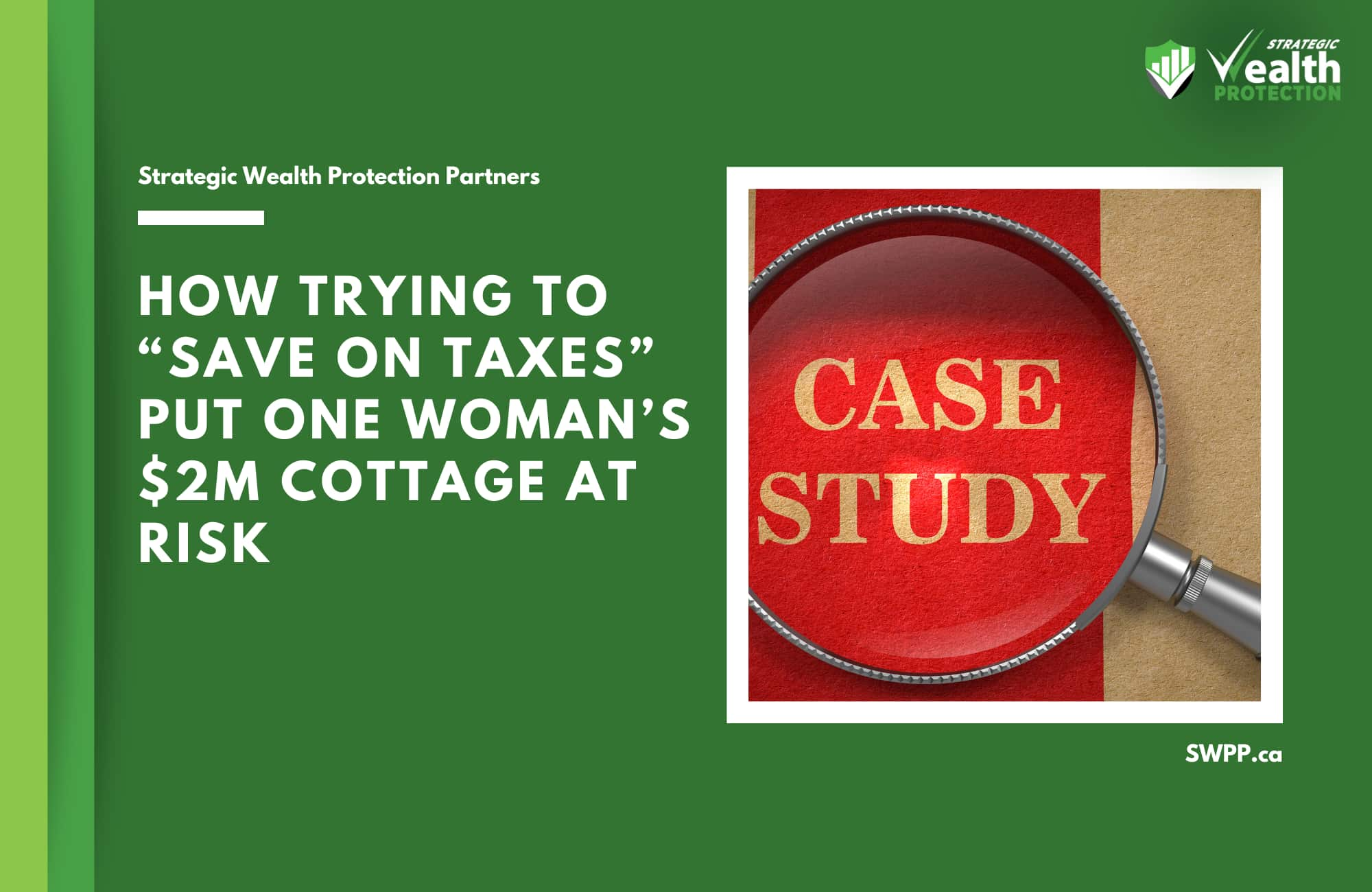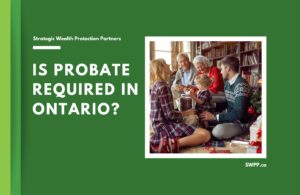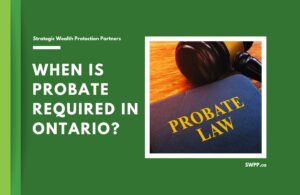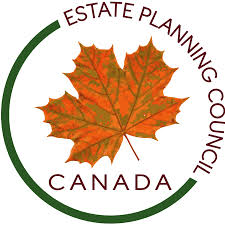Written by Ron Cooke, President & Founder of Strategic Wealth Protection Partners in Ontario, CEA®, Member of the Estate Planning Council Canada
This case study is here to act as a warning to anyone who is thinking of going rogue and trying to avoid tax liabilities without thinking through all the potential risks and downsides.
While nobody wants to pay more tax than necessary, there are better ways to deal with taxes and estate planning than trying to hide capital gains from the government. In this case study, I’ll cover the problem, what went wrong, and how this problem should have been solved.

The Problem: A Million-Dollar Tax Bill and a Family Cottage at Stake
Gabriela*, a mother of two with significant real estate holdings—including a family cottage in Muskoka—was concerned about the tax liability her children would face when she passed away. The cottage had appreciated significantly in value, and if she kept it in her name until death, her estate would owe approximately $1 million in capital gains tax.
Worried about leaving her children with a large tax bill, she took matters into her own hands—without consulting her financial or tax advisors first.
*Names have been changed to protect the identity of SWPP’s clients.
The Misguided Action: Transferring the Cottage to Her Son
In an attempt to avoid the looming tax liability, Gabriela went to her lawyer and had the cottage legally transferred into her 18-year-old son’s name.
No tax was declared. No capital gains were reported. No accountant was involved. The lawyer simply processed the legal paperwork as requested.
From a legal standpoint, the transfer was executed. But from a tax standpoint, it was a silent disaster waiting to happen.
The Consequences: Legal Liability, Unequal Inheritance, and Audit Risk
Gabriela believed the transfer had resolved her tax problem. In reality, it introduced a cascade of new issues.
Capital Gains Tax Still Owed
The Canada Revenue Agency (CRA) could audit the transaction at any time. Because she failed to report the “deemed disposition” (a required step when gifting a property), Gabriela is still personally liable for the original capital gains tax, plus she would now have penalties for not declaring the capital gain.
Her Son Now Has Legal Ownership
Her 18-year-old son now legally owns a multimillion-dollar cottage. That means:
- He can sell it at any time—even against family wishes.
- The cottage is exposed in the event of a lawsuit, marriage breakdown, or personal debt.
- The property bypasses her will, creating an unequal inheritance. Her daughter (still a minor) receives whatever is left in the estate, while her son already owns the highest-value asset.
Future Tax Liability
Any appreciation in the cottage’s value after the transfer is now her son’s responsibility. If or when he sells, he will owe capital gains tax based on its value from the time of transfer and mom or mom’s estate would also owe all the taxes and penalties on the transfer to her son which could cost double the tax bill she is trying to avoid.
This wasn’t just a flawed tax-saving move—it became an estate planning complication with emotional and financial risks.

What Gabriela Should Have Done Instead
If Gabriela had consulted an estate advisor before acting, several safer, more effective strategies could have been considered:
Scenario Planning
An advisor would have projected the future tax liability over 10, 20, or 30 years and shown exactly what her estate would owe based on different scenarios.
Using Life Insurance
Instead of transferring ownership, she could have kept the cottage and used life insurance to cover the future tax bill. This strategy:
- Would have preserved control of the asset during her lifetime.
- Protected family harmony by ensuring fair inheritance.
Used insurance proceeds—not personal or estate funds—to pay taxes when she passed.
Other Options
In some cases, transferring a property to a trust (with specific rules) or a corporation might be appropriate. Each comes with its own tax implications, legal structures, and timelines.
But the key is: all of these options require careful, personalized planning. There’s no one-size-fits-all solution—but there are definitely better solutions than a quick legal transfer.
What Will Happen If Gabriela Is Audited?
If the Canada Revenue Agency (CRA) audits this property transfer, Gabriela will likely face serious financial and legal consequences.
Here’s what will happen:
- Deemed Disposition Will Be Triggered: The CRA will treat the transfer of the cottage to her son as a sale at fair market value, even though no money changed hands. Because the cottage is a secondary property—not a principal residence—Gabriela will be deemed to have sold it and must report the capital gain.
- Back Taxes Plus Penalties: She will owe capital gains tax on the appreciation of the property up to the date of the transfer. If she didn’t declare it on her tax return, the CRA can assess back taxes, interest, and possibly penalties. With a tax liability of roughly $1 million, the added interest and penalties could push her total bill much higher.
- Increased Risk of Broader Audit: A flagged transaction like this could cause the CRA to scrutinize other areas of Gabriela’s tax filings, including her other real estate holdings or investments. What started as an attempt to “save tax” could turn into a full-blown audit of her finances.
- The Son Still Has Future Tax Liability: Even if the CRA goes after Gabriela for the initial capital gains, her son will still be responsible for capital gains tax on any future appreciation when he eventually sells the cottage. Revenue Canada could tax Gabriela on the gains when she transferred it and they could tax her son as well on the same gain as his ACB for the cottage is $0, the amount he paid for it. This would result in double taxation.
In short, if audited, Gabriela could face a six-figure or seven-figure tax bill, legal stress, and lasting damage to her estate plan—all of which could have been avoided with professional advice and proper planning.
What to Remember
Avoid costly shortcuts.
A simple decision made without expert guidance can create years of legal and tax complications and strain your family.
Before making major decisions about transferring property or avoiding tax, consult an estate planning and tax advisor who can walk you through the real financial impact, timeline, and risks of every option.
As Gabriela’s story shows, what seems like a smart move can quickly unravel without a full plan.
Discover How to Minimize Taxes and Secure Your Legacy
Did you know that without a solid estate plan, taxes and fees in Ontario could claim a significant portion of your wealth?
If you’ve worked hard to build your business, investments, and properties, protecting your legacy for your loved ones is critical. At Strategic Wealth Protection Partners, we specialize in helping high-net-worth individuals in Ontario secure their financial futures.
Our Living Estate Plan is designed to:
- Reduce estate taxes and probate fees.
- Simplify wealth transfer to your loved ones.
- Reflect your values and priorities in every detail.
Your Legacy Matters
With our personalized guidance, we’ll help you navigate options like Living Trusts to protect your assets and ensure your family’s peace of mind. Contact us today to book your Living Estate Plan Consultation and take the first step toward a secure future.
Schedule a Living Estate Plan Consultation
Planning your legacy is about more than numbers—it’s about ensuring your family remembers you and your values are honoured for many years to come.
Estate planning and trusts can feel overwhelming, especially if it’s your first time. That’s why we’re here.
With our simple, 5-Step Living Estate Plan, we make the process easy, helping you create a comprehensive estate plan or trust that protects your assets from taxes and probate fees while preserving your legacy. Tools like The Final Word Journal capture your story, wishes, and essential details like accounts and end-of-life plans, ensuring your family has clarity and comfort.
Take the first step today—schedule a consultation call and give your family the ultimate gift: peace of mind and the assurance they were always your priority.
Read More
If you’re starting your estate planning process, you may find these articles helpful:
- Case Study: How Bill Protected His Children’s Inheritance with a Trust
- How to Avoid Capital Gains on a Cottage in Ontario
- How Much Is an Estate Taxed in Canada?
About the Author
RON COOKE, PRESIDENT & FOUNDER OF STRATEGIC WEALTH PROTECTION PARTNERS

With over 30 years in financial services, I’ve seen the challenges families face when a loved one passes—lost assets, unnecessary taxes, and emotional stress. That’s why I created the Living Estate Plan, a comprehensive process to protect assets, eliminate estate and probate fees, and create legacies that are remembered for many years to come.
This plan ensures your family receives not just your wealth, but a meaningful reminder of your care and love. Tools like The Final Word Journal capture your story, wishes, and essential details, offering clarity and comfort during difficult times.
Your final gift should be more than money—it should be peace of mind, cherished memories, and an organized estate.
Schedule a Call
Schedule a 30-minute consultation call with Strategic Wealth Protection Partners.
Click HERE to schedule a consultation.









